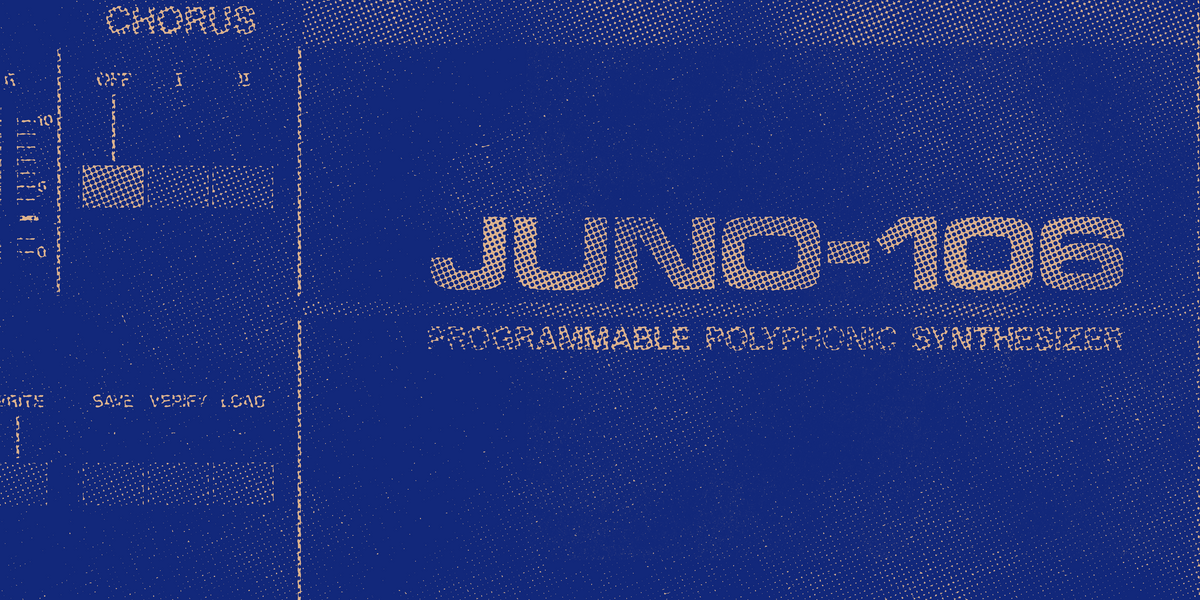The deserved love for the Roland Juno 106
An icon of the synthesizer world and an eternal fixture for studios across the planet. But will it always be this way?

How we feel about any given object or aesthetic is as much a sign of the era we live in as any objective evaluation. Especially the objects that become totems and symbols in their own right. Which is amazing, if messy, to see engineering and industrial design become iconic. And create a whole new wave of art and inspiration as a result. Even more amazing, and messy, is the fact that Roland has managed to be at the center of many iconic symbols of a generation almost in spite of it's recent product design choices.
As a case in point, it's over four decades have passed since Roland released the Juno-106, a polyphonic synthesizer that quickly established itself as a foundational instrument in the world of electronic music. Its impact was so profound that it remains an essential tool in the music industry today. The Juno-106 is more than just a synth; it's a piece of history, a distinct timbre embedded in the DNA of numerous music genres, from pop and rock to house and techno.
The Birth and Design of a Legend
The creation of the Juno-106 was part of Roland's broader efforts in the early '80s to democratize the synthesizer, a mission rooted in a blend of innovation, function, and affordability. The predecessor of the Juno-106, the Juno-60, introduced the world to a then-unique combination of analog warmth, polyphony, and user-friendly programming, but lacked in MIDI implementation. The Juno-106, introduced in 1984, emerged as a significant upgrade, bringing with it a host of new features and improvements.
Physically, the Juno-106 boasts a sturdy design, a 61-key keyboard, and a control panel featuring a series of sliders and buttons for parameter adjustment. Each feature was designed with the user in mind, providing hands-on, intuitive access to the synthesizer's inner workings.
At its heart, the Juno-106 hosts a single digitally controlled oscillator (DCO) per voice, which can produce sawtooth, pulse, square, and sub-oscillator waveforms. The DCO ensured stable tuning – a common issue with earlier analog synths – while preserving the organic warmth of analog circuitry.
The 106 also sports a Voltage-Controlled Filter (VCF) known for its smooth and musical resonance. The VCF could be manipulated by an envelope generator, an LFO, and keyboard tracking, providing ample room for sound shaping.
The crowning glory of the Juno-106, though, is its Chorus effect. Implementing a pair of analog Bucket Brigade Delay (BBD) lines, the Juno's Chorus produces a lush, shimmering effect that has become the synthesizer's sonic signature.
The Iconic Juno Sound
The Juno-106 is famed for its lush pads, meaty basses, and electrifying leads. With a sonic palette that spans from silky and sweet to raw and aggressive, the 106's sound is characterized by its richness and depth.
Perhaps the most iconic sound of the Juno-106 is its lush pads. Dialing in a soft sawtooth wave, opening the filter, and engaging the Chorus, the Juno creates wide, spacious soundscapes that feel both intimate and expansive.
For bass sounds, the Juno-106 can get punchy and deep. Using the square wave with pulse-width modulation, cutting off some high frequencies using the filter, and adding a touch of resonance results in a thick, warm bass that's perfect for anything from funk lines to EDM patterns.
When it comes to leads, the 106 can cut through any mix with its sharp, rich timbres. By pushing the resonance on the VCF and utilizing the pitch bend lever, the synth can generate sizzling leads that carry a significant amount of expressive potential.
A Staple of Modern Music: Classic Tracks Birthed by the Juno-106
The Juno-106’s footprint can be traced in some of the most iconic tracks of the past decades. Daft Punk's "Digital Love" showcases its warm and vibrant capabilities, while the entire '80s genre of synth-pop was practically fuelled by the Juno's distinct tone. Aphex Twin’s “Selected Ambient Works 85-92” album is a masterclass in the application of the Juno’s sonic versatility. The 106 has been a cornerstone of dance music, providing the cornerstone sounds for genres such as deep house, acid house, and techno.
The Juno-106 Hype: Overrated or Deserving?
As with any revered piece of music gear, the Juno-106 has seen its fair share of hype. Some critics argue that the synth's ubiquity and celebrity status have inflated its reputation beyond its actual capabilities. They point out the limitations of its single DCO, the lack of multimode filter, or the absence of a second envelope generator as reasons it may not live up to the modern synth standards. Yet, many fans and users argue that the charm and the magic of the Juno-106 is precisely its simplicity, its directness, and that unmistakable, inimitable tone.
The challenge in evaluating the idea of hype is that there's no objective perspective. For those of us who grew up using Junos, there's the mix of familiarity bias, nostalgia, ease of use, and sheer muscle memory. These in turn inform the language that we use... snappy envelopes, lush chorus, smooth filters, heavy bass, and so on. Subjectively the result of decades of a cultural resonance built around a common creative language. The love for the Roland Juno series is certainly more than the other instruments of our generation - although the Korg MS-20 isn't too far behind (and I've written about the Yamaha CS-80 and ARP 2600 being similarly esteemed but more visibly passed over if not more agreeably overhyped). But whatever the case, this is the synthesizer with a community that doesn't seem to die down.
Digital Echoes: The Rise of Juno-106 Emulations
As digital technology has advanced, software developers have made considerable efforts to emulate the Juno-106's iconic sound in the form of plugins and digital synths. The purpose is to offer the 106's iconic sound and functionality in a more accessible, affordable, and convenient package.
TAL Software's U-NO-LX plugin is one such example, mirroring the Juno's design interface and aiming to recreate its analog warmth and thickness. It incorporates the Juno's oscillator, filter, and envelope sections and even includes the legendary Chorus effect.
Arturia's Jup-8 V, while primarily a Jupiter-8 emulation, also carries Juno-106 features. It offers extended functionalities such as the addition of a sequencer, extra modulations, and effects, all packaged within Arturia's well-regarded Analog Lab environment.
Meanwhile, Roland themselves released the Roland Cloud Juno-106, a plugin that uses Analog Circuit Behaviour (ACB) technology to model the original Juno's sound and behavior. It aims to offer the most authentic replication of the original synth.
Softube's Model 84 Polyphonic Synthesizer is another noteworthy mention. It meticulously models the individual components of the Juno-106, resulting in an emulation that is both sonically and visually faithful to the original.
However, while these digital emulations have made strides in replicating the 106's sound, many purists argue that there is an elusive quality, a certain "magic," to the original hardware that software can't fully capture – the subtle imperfections, the warmth, the tactile experience of the knobs and sliders. As a result, while these emulations have their place, they seem destined to coexist with, rather than replace, the legendary Juno-106.
The Juno-106's Lasting Legacy
The story of the Juno-106 is still being written, even after decades. It continues to shape sound and inspire creativity, maintaining its place in studios around the world. Its sound is still revered, its design still admired, and its impact on music, undeniably pervasive. It's hard to imagine the Synthwave genre without it. The Juno-106 stands as a testament to Roland's genius, the power of simplicity, and the timeless nature of good design. It is an enduring icon in the music world - a legend in keys that will resonate with music-makers for generations to come.


